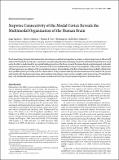| dc.contributor.author | Sepulcre, Jorge | |
| dc.contributor.author | Sabuncu, Mert R. | |
| dc.contributor.author | Yeo, Thomas B. | |
| dc.contributor.author | Lui, Hesheng | |
| dc.contributor.author | Johnson, Keith A. | |
| dc.date.accessioned | 2013-02-12T22:44:33Z | |
| dc.date.available | 2013-02-12T22:44:33Z | |
| dc.date.issued | 2012-05 | |
| dc.date.submitted | 2012-05 | |
| dc.identifier.issn | 0270-6474 | |
| dc.identifier.issn | 1529-2401 | |
| dc.identifier.uri | http://hdl.handle.net/1721.1/76790 | |
| dc.description.abstract | How human beings integrate information from external sources and internal cognition to produce a coherent experience is still not well understood. During the past decades, anatomical, neurophysiological and neuroimaging research in multimodal integration have stood out in the effort to understand the perceptual binding properties of the brain. Areas in the human lateral occipitotemporal, prefrontal, and posterior parietal cortices have been associated with sensory multimodal processing. Even though this, rather patchy, organization of brain regions gives us a glimpse of the perceptual convergence, the articulation of the flow of information from modality-related to the more parallel cognitive processing systems remains elusive. Using a method called stepwise functional connectivity analysis, the present study analyzes the functional connectome and transitions from primary sensory cortices to higher-order brain systems. We identify the large-scale multimodal integration network and essential connectivity axes for perceptual integration in the human brain. | en_US |
| dc.description.sponsorship | Alzheimer's Foundation of America (Grant NIRG-11-205690) | en_US |
| dc.description.sponsorship | Alzheimer's Foundation of America (Grant ZEN-10-174210) | en_US |
| dc.description.sponsorship | National Institutes of Health (U.S.) (NIH Grant K25NS069805) | en_US |
| dc.description.sponsorship | National Institutes of Health (U.S.) (NIH Grant K25EB013649-01) | en_US |
| dc.description.sponsorship | National Institutes of Health (U.S.) (NIH Grant R01AG037497) | en_US |
| dc.description.sponsorship | National Institutes of Health (U.S.) (NIH Grant R01AG036694) | en_US |
| dc.language.iso | en_US | |
| dc.publisher | Society for Neuroscience | en_US |
| dc.relation.isversionof | http://dx.doi.org/10.1523/jneurosci.0759-12.2012 | en_US |
| dc.rights | Article is made available in accordance with the publisher's policy and may be subject to US copyright law. Please refer to the publisher's site for terms of use. | en_US |
| dc.source | SFN | en_US |
| dc.title | Stepwise Connectivity of the Modal Cortex Reveals the Multimodal Organization of the Human Brain | en_US |
| dc.type | Article | en_US |
| dc.identifier.citation | Sepulcre, J. et al. “Stepwise Connectivity of the Modal Cortex Reveals the Multimodal Organization of the Human Brain.” Journal of Neuroscience 32.31 (2012): 10649–10661. Web. | en_US |
| dc.contributor.department | Massachusetts Institute of Technology. Computer Science and Artificial Intelligence Laboratory | en_US |
| dc.contributor.mitauthor | Sabuncu, Mert R. | |
| dc.relation.journal | Journal of Neuroscience | en_US |
| dc.eprint.version | Final published version | en_US |
| dc.type.uri | http://purl.org/eprint/type/JournalArticle | en_US |
| eprint.status | http://purl.org/eprint/status/PeerReviewed | en_US |
| dspace.orderedauthors | Sepulcre, J.; Sabuncu, M. R.; Yeo, T. B.; Liu, H.; Johnson, K. A. | en |
| dc.identifier.orcid | https://orcid.org/0000-0002-5002-1227 | |
| mit.license | PUBLISHER_POLICY | en_US |
| mit.metadata.status | Complete | |
